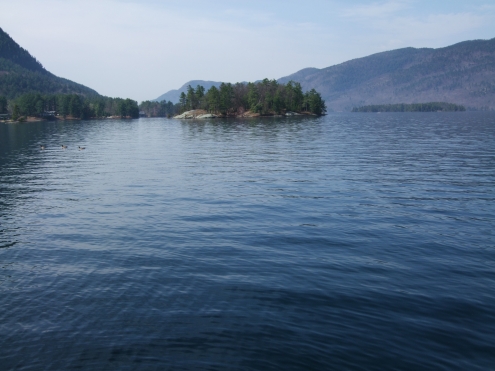Lake George water quality data for 2010 has been released by the Citizen Statewide Lake Assessment Program (CSLAP). Since 2004, the Lake George Association has participated in CSLAP, which is coordinated by the New York State Dept. of Environmental Conservation (NYS DEC) and the New York State Federation of Lake Associations.
In 2010, LGA volunteers monitored mid-lake sites near Diamond Island, Harris Bay, Basin Bay, Huletts Landing, Gull Bay and Hearts Bay. Each year, volunteers collect and process water samples throughout the summer. The samples are mailed to a lab for analysis, and then results are reviewed and compiled by NYS DEC staff. Summary and detailed reports for 2010, as well as scorecards for each site, are available on the Lake George Association website along with reports and data from previous years. Some of the key findings are as follows:
Water Clarity
Lake George continues to be characterized as oligotrophic at all sites, based on water clarity, total phosphorus readings and chlorophyll a readings. Water clarity was lower than normal in 2010 at the Harris Bay site, and higher than normal at the Hearts Bay site. Neither of these sites exhibited a change in phosphorus or chlorophyll a readings in 2010, although there has been an increase in the water clarity readings in Basin Bay since 2004 (although nearly all water transparency readings at this site have been high). Total phosphorus readings were slightly higher than normal at the Gull Bay site in 2010, though this did not lead to a change in chlorophyll a or water clarity readings. Phosphorus readings were close to normal in 2010 at the Diamond Island site, but these readings have been lower in the last three years than in the period from 2004 to 2007.
Potability
Algae levels are not high enough to render the lake susceptible to taste and odor compounds or elevated DBP (disinfection by product) compounds that could affect the potability of the water. Hypolimnetic phosphorus, ammonia, iron, manganese and arsenic readings are low or close to those measured at the lake surface at all sites.
Chemical Presence
With the exception of a slight decrease in pH readings at the Huletts Landing site (which is probably not ecologically significant), there has been no long-term change at any of the sampling sites. Nitrogen oxide (NOx) readings were higher than normal in 2010 at all sampling sites except Harris Bay and Hearts Bay, and ammonia readings were higher than normal at the Basin Bay, Gull Bay, and Hearts Bay sites, although all readings for both NOx and ammonia continue to be low. Calcium readings were higher than normal at the Diamond Island, Basin Bay, Gull Bay, and Hearts Bay sites, but lower than normal at the Huletts Landing site. Calcium levels at each of these sites remain marginal for supporting zebra mussels, although near-shore calcium levels may be higher at some of these sites. Color readings were lower than normal at the Huletts Landing and Gull Bay sites in 2010, and pH readings were lower than normal at the Hearts Bay site in 2010.

